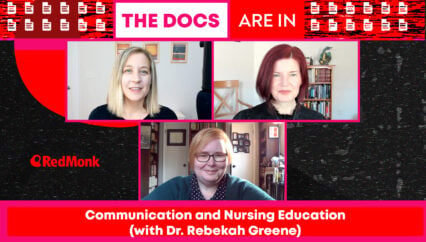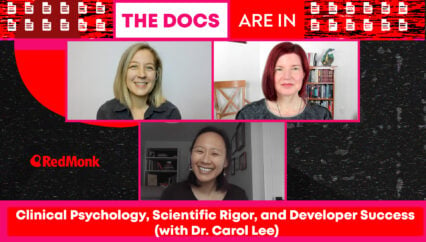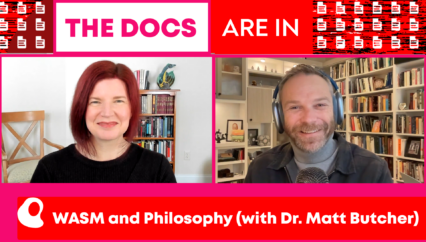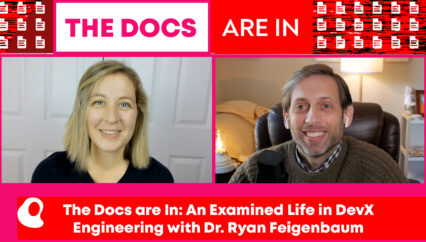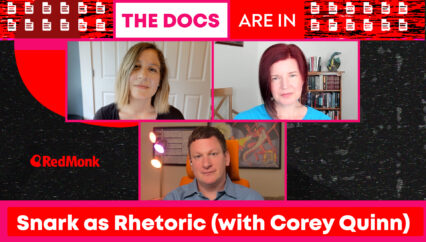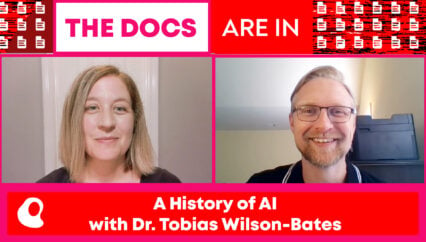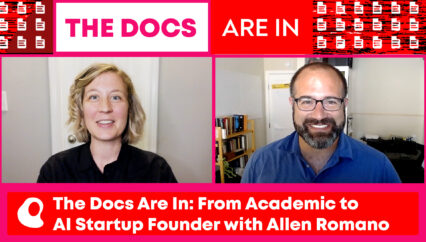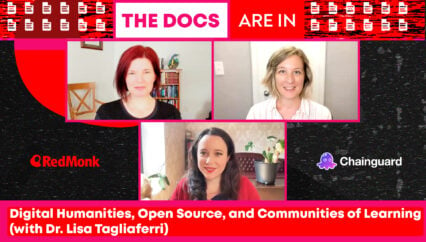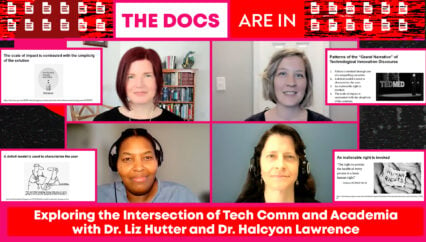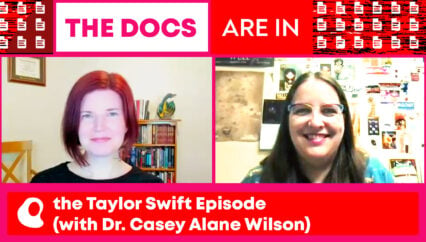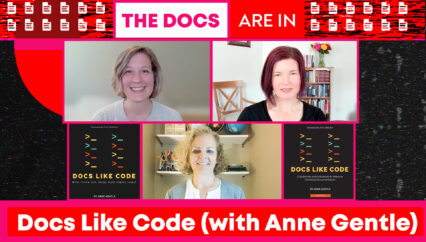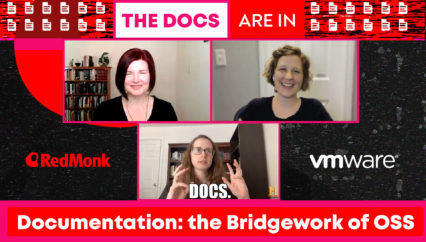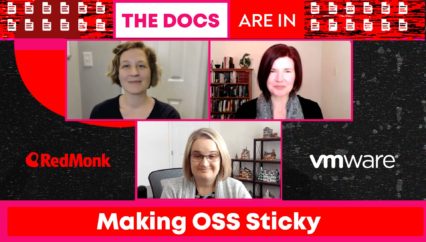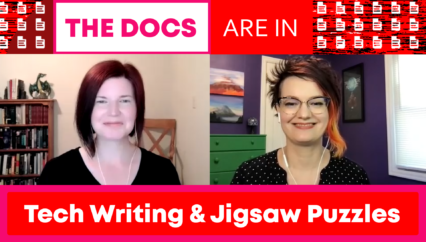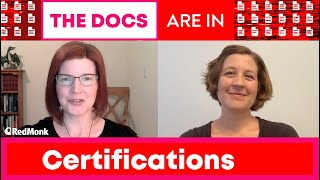Kate Holterhoff, industry analyst at RedMonk discusses upskilling, reskilling, and cross-skilling with Angela Andrews, Solution Architect at Red Hat & Co-Host of the Compiler Podcast. They get into a range of topics including Upskilling’s Greenfield Problem, whether certifications are enough to secure an entry-level job in tech, the value of bootcamps, and how Red Hat is meeting the needs of learners.
This was a RedMonk video, sponsored by Red Hat.
Rather listen to this conversation as a podcast?
Transcript
Kate Holterhoff: Hello and welcome to this episode of The Docs are in. My name is Kate Holterhoff, Industry Analyst here at Redmonk. And with me is Angela Andrews, Solution Architect at Red Hat and co-host of the Compiler podcast. I am beyond thrilled to welcome Angela here to discuss her experiences, opinions and philosophy on the subject of upskilling. In addition to championing non-traditional students on their upskilling journey by volunteering with groups like Girl Develop It and Python for All as an AWS certified Solutions Architect and a member of the 2019 Red Hat Accelerators program, Angela has real world lived experience with the challenges and opportunities afforded to those looking to upskill in tech. Angela, thanks so much for joining me today.
Angela Andrews: Thank you so much for having me, Kate. I’m very happy to be here and to chat with you.
Kate: All right. Let’s begin with some background. Tell me about your education and professional history. What was your journey to becoming a Solution Architect like?
Angela: I think I took the long way around. Some would say I worked in higher ed as a systems administrator for many years, and someone approached me about becoming a Solution Architect and I thought, “Oh, I don’t know how to architect. What are you talking about?” It was one of those things where someone had to convince you that the skills that you have are the skills that are needed for this role. I didn’t know any Solution Architects. A friend of mine had sent me a job posting. I applied, I got the job, and the rest, as they say, is history. I’ve been here over two years going on three, and it’s been a wild ride. It’s a very rewarding job, I have to say.
Kate: Wonderful. So I wanted to begin our conversation just by laying out some terminology here, because we are going deep into the topic of upskilling. So just want to define some terms just to be clear, because they can be a little bit murky. So upskilling is intended to help employees develop new, deeper competencies that are tied to their current role, whereas like reskilling prepares them to transition into new roles within an organization. And then you’ve got cross skilling, which develops skills that are valuable across multiple functions and is useful to mitigate risk tied to information silos. So, you know, what I’m hoping that we can talk about is, you know, as someone who has mentored and experienced all of these skilling trends, what hurdles have you noticed that students experience when trying to upskill, reskill or cross skill?
Angela: There’s so many things that you come up against when you’re trying to set your prefix skill. Like it depends on the prefix, but when you’re trying to maybe change jobs or reskill or learn those skills, what we come up against is, you know, what are those skills that we need? So we usually take to Google or we take to YouTube. And I’m a fan of doing informational interviews, finding someone who does the job that you want to get into and talk to them and find out what, what skills they use and what skills they think are important. And you can kind of craft almost like a syllabus of how to take those little nuggets that you’ve gotten from someone and to build a curriculum. Now we’re humans and we like to do things that are shiny and, you know, that catch our attention: the latest, greatest buzzword. And that’s great. But I think how to be able to skill ourselves properly is to find something dedicate to it. Make sure you have some sort of mastery that you can speak to it. I do recommend to folks, if you’re on this journey to maybe upskill or cross skill is to write about it. I find that when you learn in public, when you talk about what you’re learning and how you’re learning, people tend to like that. And when they see the constant thread of your growth and how you’re learning this new skill or how you’re learning this new technology, this is also helping you build your brand and put yourself out there for your next great employer. Because they can see what you’ve done to gain these competencies and they can kind of travel along your journey with you by reading your blog and checking out your socials and things like that. So the hurdle is to get started and to get over the hurdle is to just start doing it and then writing about it and being public about it. I know that’s not easy for a lot of folks, but I see it time and time again and I do think it works.
Kate: I’m a big advocate of writing to figure out what I’m thinking. A lot of times I’ll have these sort of nebulous ideas about what it is that I’m looking at and how I’m experiencing something. But it’s not until I put it down on paper, or more often type it out on my computer that I actually kind of understand how it fits into my larger experience of trying to contextualize, you know, in this case, technology. So I couldn’t agree with you more. And, you know, places like Mastodon and Twitter in particular seem like really fertile areas where we can try to learn in a community setting.
Angela: I agree with you. So I want to say communities are everything. And I think I posted those exact words yesterday on LinkedIn. Community is everything. This is how you reach like minded people. This is how you learn. This is how you glean more information. This is — your community is what builds you up. And it could be people that you’ve never met in person. You’re only talking to them because you’re in this particular community or you’re following a particular hashtag. And, you know, like minds tend to gravitate together. I’ve had so much success in online communities, meeting people, getting opportunities, learning new things. It’s been invaluable for me in my career. And that again, is why I think social media is really a great tool if it’s used properly to help you on your journey. I can’t say enough good things about it.
Kate: And speaking of learning in public, I’m an avid Compiler fan and was particularly moved by the story of Jameel Alston, a delivery driver who studied for and passed the AWS Cloud Solutions Architect Certification exam. So there are a number of important lessons that this segment communicated to me. But the first relates to the tenacity of Alston, who worked so hard to pass the exam and ended up taking it twice before passing. So the second relates to the pipeline of certifications to job placement. A lot of times vendors make it sound like holding a certification will get you a job. So I really appreciated that. On Compiler, you and your co-host made it clear that even after passing his exam, Alston will need to complete labs and build up his portfolio before he’s prepared to land a job in tech. Can you give me any more insight or details into Alston’s story, and why is it so important for us to talk about journeys like his?
Angela: Well, the certification is not the end game. We study hard to pass it, but that’s just the tip of the iceberg. How do you let future employers know that you know what you’ve studied? And that’s where building your body of work comes in. So for him, it would be writing about technologies that he’s using, or projects that he’s creating in AWS and developing pipelines, and how he can he can enumerate and explain all of the things that he’s using. And, you know, if he uses a tool like, say, GitHub where you can see his code and the work that he’s done, he’s constantly producing. So that is literally part of your CV. You know, if you’re out there and you don’t have the 1 to 3 years experience that a lot of employers are asking for, if you’ve taken your time to build out that body of work, that really does help. It’s not you know — it doesn’t help for every position because sometimes employers do want people with a lot more hands on experience. But at the very least, you’ve done yourself a service by not just studying for the exam and learning the tools that way, but building things and integrating what you’ve learned into maybe other tools and other products and learning how all of this works together. Understanding networking, understanding Linux, understanding the security aspect of it, and being able to speak to that via a blog or putting something out on LinkedIn. Again, you have to let people know that you know what you’re talking about, and if you don’t have the experience, well, let your portfolio speak for you.
Angela: You know, let your LinkedIn and the posts that you put out there, let it speak to you. And I also say that you should start talking to like minded folks. So find other Solution Architects out there on Twitter and other other socials and what are they putting out and what kind of blogs and articles are they posting? Well, maybe you can repost and comment and put your own commentary because now you’re a thought leader in these areas and it doesn’t feel like you’re doing it. But you’re showing folks that “I get this, I understand this.” And I recommend that for anyone who is, you know, upskilling and trying to get into this field. Definitely the learning in public model works because if you’ve ever filled out a resume or an application and submitted a resume, someone is literally going to start Googling you. And when your name comes up and they see, Oh, look at this LinkedIn profile, this person is — he does have a lot of information about this particular technology or this particular cloud or this particular tool, and you’re letting your work talk for you. So I know Jameel is going to get a job like soon because he’s so hungry and people like him that are so hungry, they’re going to do what it takes to get their foot in the door. I have no doubt.
Kate: That’s great and inspiring. You know, I just spoke to some undergrads about the importance of curating your online persona, and we certainly talked about making sure that your LinkedIn — at least, your about section — is, you know, clear, speaks to the right audience. But also having a portfolio, whether that’s GitHub or something that you built on your own as a sort of, you know, standalone site or app. And then also just making sure that that when folks Google you (because they will), that they find this sort of narrative that you want to present to the world. And, you know, writing, blogging, having a robust social media presence is all key to that. Makes a lot of sense.
Angela: Good advice. That’s very good advice.
Kate: Yeah, it seemed to resonate. So let’s talk a little bit about certifications and where they fit in here. So I’ve written about what I’m calling upskilling’s Greenfield Problem in which, instead of teaching and assessing competencies based upon real world, messy sort of brownfield stacks and processes — the kind of thing that requires debugging, authentication, version control, especially… education portfolios for certification programs, tend to be a little more best case scenario. So the sort of experiences that students get from bootcamps, certifications and badges tend to be a little more rudimentary, sterile. And I guess, they get you to that “hello world” stage but can’t get you beyond there. So what is your sense of this problem and how can organizations help students to succeed in the real world when they’re actually in a job that that requires them to deal with legacy code and less ideal situations?
Angela: Well, the first thing is having those types of scenarios available for people to learn from — not having the perfect situation, making people troubleshoot. Things are broken… how do you fix it? Learning them, those troubleshooting techniques, you know — how to look at logs, how to understand network traffic, how to understand and read error messages and decipher, and using your Google-fu and using your documentation, being able to do those things. I went to a boot camp and one of the few things that was lacking is they not taught us how to use GitHub. Now I was lucky enough that I had that experience, but can you imagine doing coding without some sort of a source control? It was — when I look back on it, we learned it at the very end and I was like, “How can you not tool people properly?” Like these are the basics. Being able to understand how packets travel, being able to understand, if a network goes — a network problem happens, how do you troubleshoot, you know? So we need to set up those types of scenarios where everything goes wrong and we have to think about, well, how do we solve them? And I think that’s being very intentional and not giving students this very pristine environment in which to learn. Give someone something that’s broken and have them figure it out.
Angela: You get to see how they think. You get to see how they troubleshoot. You get to see how they figure things out. And that to me is invaluable. Like it’s great that you get all these other things, but being able to figure it out and make sure that it works is key. Nothing tops that, in my opinion. That’s where the real world comes in. Having been a sysadmin for many years, I know what that feels like. I know that you have to break things and things have to be broken and you have to bring them up and you have to figure it out as quickly as possible. So, you know, again, certifications I think are amazing. They’re invaluable because they give you that baseline understanding of a particular product or tool or software, and from there is where you grow your skills. So, I think instructional institutions, however you want to call them, they have to make sure they give you some of that included. If you’re not troubleshooting, if you’re not figuring out if something’s broken, how to fix it, you’re really going to do your students and the people who use your service a really big disservice. Just my $0.02 on that.
Kate: Well, I’m glad we talked about boot camps, actually, because some can be quite pricey. I’ve spoken with several boot camp graduates who weren’t able to jump directly into tech careers after graduating. And, yet I’m a non-traditional student myself. And when I was studying to become a front end engineer after spending a decade as a university instructor, I often wished I had attended a boot camp to get the sort of structure and support that online tutorials and books — they just can’t offer. So I think a lot about the role of education portfolios. And I think another part of it that I think we’ve touched on a little bit is how they can serve to do good. And of course, you’re involved in a number of different nonprofits and places to try to help folks enter the tech space and try to advance their career here. And I think another place where I’ve noticed a lot of folks bringing up certifications and education more broadly has been their ESG reports. And so, we don’t need to go into that in detail. But I think it’s just so interesting that companies will frame their educational initiatives as part of how they’re doing good. You know, part of this narrative of how they’re helping the world. And so I guess, oftentimes enterprises frame these as a means specifically to bring in sort of non-white, non-US, non-male voices to the table. And so in your opinion, are these certification providers just paying lip service to the notion of doing good and trying to make tech into a more diverse, more welcoming space? Or do you think that certifications are actually part of that equation that they’re actually helping to make tech a better place?
Angela: Well, I do think it’s helping. I think the simple fact that they exist and if they’re trying to — “they” meaning the companies that are putting this content out there and they’re trying to enrich the pipeline, as they say. One, you know, cash is everything. If they’re making money, that is really always going to be the most important thing. Is this enterprise making money. Now, if you can make money and do good at the same time, well, great for you. But some of it is performative, I would have to admit, because if you’re not giving people, the tools and the leg up and the constant feeding-through and nurturing because — say if you’re a person and you’re a non-native English speaker and you’re looking to get into a program, well, the technology is not your only barrier. And if companies aren’t tending to the whole student and the whole person, you know, the language barrier, well, that’s something that needs to be addressed or other things that have little to nothing to do with the technology. If those things are not being addressed as well, then how accessible is it? So I hope most institutions aren’t paying lip service to this, but they’re really meaningful and they’re doing something to help people to get into these spaces. But, you know, it deals with the whole person. If this institution can deal with the whole person and their understanding of this person’s background and their particular struggles or anything like that, that could be a barrier and help lift people up, I am all for it. But I have to say a lot of it sometimes can be performative and can do learners a disservice in the end. So I say beware. I say talk to people. I say, the best thing about the Internet is that it’s vast and you can probably find another person who’s gone through this particular program or taken this certification and ask them, “what did it do for you or how did it help you and how did they empower you and enable you?” And if those answers sing to you and speak to you, then you’re making the right decision. But if you’re hearing things that don’t necessarily sound right or it sounds like they’re just shoveling people through and that doesn’t help you or it could probably hurt you, then that might not be the enterprise for you. So do your homework. There’s a lot of information out there. There’s always people who’ve gone through it before you, and they’re going to have a strong opinion about it. Right? For good or for bad. I do agree that a lot of it can be a little detrimental, but there’s a lot of great institutions out there that are doing good work and helping folks upskill and get into tech, which I absolutely tip my hat to because there’s really not enough of us out there.
Kate: Yeah, I think that’s a really great way to lead to our last question for this conversation. And that is, how is it that educational providers can accommodate a range of learning experiences in their students? And specifically, how is Red Hat meeting the needs of these learners?
Angela: So I talk about this often. People learn in different ways, different modalities. You can’t have one sort of curriculum and think it’s going to speak to the masses. You might have to be a little bit more creative on how people learn. You have to meet them where they are. And I think Red Hat does a pretty good job at this. They do offer a lot of training in different forms and different ways to consume the same information. So if you’re more an auditory learner, maybe you can listen to a video or if you’re more hands on person, there’s labs and things available for you to try out. As someone’s talking, you’re trying to do the learning of the thing. It really does matter to understand the learner. You know, putting all of your credence into the content. Well, you’re not sure how folks are going to receive said content, and I’m always going to make sure, especially because I do a lot of mentoring in certification preparation here inside of Red Hat and outside of Red Hat, you have to figure out how people tick. And how do you do that? Well, you have to talk to them, right? You have to figure out what works for them. And I’m not always for a person having to out themselves and say, well, you know, maybe they’re neurodiverse or maybe they have a learning challenge. But it’s having conversations or allowing people to pick from different ways of learning said material. It is so helpful. Some people need different modalities. And if you’re serious about upskilling and training your folks and getting people enabled, then you need to be aware that people learn in different ways. And if you’re serious about helping people learn, then you’re going to make sure that those different ways are available. So I think Red Hat does a pretty good job. You’d be surprised. I think a lot of people are understanding that this is a thing and people do learn in different ways. But we can’t forget that, we can’t push mandates and things on people without realizing that, well, maybe this is not how our populace learns. How do we make sure that we’re reaching everybody? So I try to be vocal about that. And because I would want someone to speak up for me. And I’ve seen it in my — doing tutoring or TA’ing in bootcamps and things like that where people learn differently and you have to sometimes pull people to the side and help with the one on one. And I know that can be a time sink, that, you know, time is money. But if you want people to grow and excel, I think it’s well worth it.
Kate: As a former educator, I couldn’t agree with you more. I think that that sort of attention to what it is that these learners need as individuals, taking cognizance of their background and just being responsive to what it is that they’re bringing to these situations and trying to help them to do the best that they possibly can is absolutely critical. So I want to thank you, Angela, for taking the time out of your day to join me to talk about upskilling. And I will certainly provide some links to your own writing to make sure that folks can follow that and follow you as you continue to learn yourself and discuss ways that you’re facilitating education in your own life. And with that, the docs are out.
